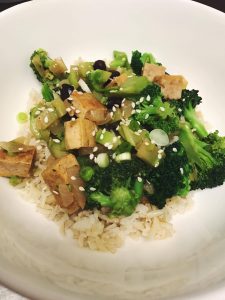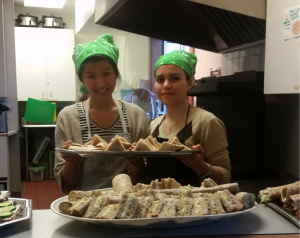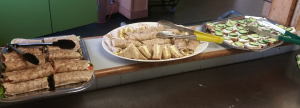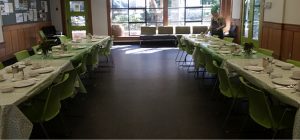Hello everyone! We hope you are excited to read this posting, as it has been awhile since our last post. Since then, we have worked long but rewarding shifts at the Gordon Neighbourhood House. Below we will provide an update on our weekly objectives and achievements. Unfortunately, we only have a month remaining until we are finalized with our project, therefore we want to share our moments of significant change throughout our project with you. But, enough with the negatives because we are ecstatic after having the opportunity to facilitate our first proposed meal! Curious to find out if our meal was a success? Read to find out!

Our “upbeet” community partner Joey!
“Together We Grow”
– Gordon Neighbourhood House
Last week was one of our second important meetings with our community partner at the GNH, in which we discussed various methods to utilize in ensuring our proposed meal would be a success. It was an exciting experience because we had the opportunity to work alongside the GNH to structure a meal that was suitable for both the GNH and our group‘s goals. It was a necessary process as we had to discuss the available ingredients and budget. After careful consideration of the GNH requests, we agreed to prepare a delicious Thai Peanut Chickpea Nourish Bowl the first week and a Mongolian Tofu and Broccoli Nourish Bowl the following week! We decided to cook in teams of three to maximize space and efficiency of service. The first service has been completed and went smoothly. We obtained the required qualitative information from the interviews we conducted with the chef our community partners, the GNH volunteers, as well as handed out surveys for the guests to complete. The overall feedback was positive and the community members were excited about the fresh variety of colors in the new dish. Round one was overall a success and we look forward to trying the other dish next week! Below is a summary of our weekly objectives and strategies to achieve them (weeks 9-11), a discussion regarding the Moments of Significant Change Workshop, as well as our proposed strategies for a successful project completion.
Weekly Objectives
Week 9 (March 6th- 10th)
Objectives:
- Prepare and serve our meal on March 8th at the GNH.
- Conduct our survey for the GNH guests to assess the suitability of our menu outline.
- Interview the chef, the volunteers, and the GNH community partners.
- Coordinate a meeting on March 10th to discuss our successes, moments of significant change and future objectives for our second visit.
Strategies on how to achieve them:
- Integrate feedback from collaborative meeting into our intervention plan.
- Effective planning and organization is necessary towards facilitating a successful intervention. Each group member will have a specific task that will allow the intervention to go smoothly.
- Designating particular tasks throughout our group to limit the amount of uncertainties we might encounter.
- Discuss and collectively agree as a group to remain level-headed in high-stress situations to ensure our success.
Week 10 (March 13th – 17th)
Objectives:
- Prepare and serve our second meal on March 15th at the GNH.
- Conduct our second survey for the GNH guests.
- Interview the chef, the volunteers, and the GNH community partners for a second time.
Strategies on how to achieve them:
- As the week before, we will utilize the same strategies to ensure that the second meal that we are serving goes just as well as the first one did. That way we can ensure to have a successful project and obtain the best qualitative information.
- Ensure that the work is divided evenly among group members to maintain team unity, fairness, and equality. In addition to having pre-assigned tasks during our intervention, we will create a schedule of tasks to ensure the lunch is prepared in a timely manner.
- Gather and organize all of our information into a folder to prepare for synthesis and analysis which will be shared with GNH.
Week 11 (March 20th – 24st)
Objectives:
- Put all of the information and data obtained from week 10 & 11 into excel and word documents in order to be analyzed for analysis of our implemented menu change’s success and shortcomings.
- Interpret the information and data to identify if our meal may help the GNH to improve their Wednesday lunch programs.
- Begin preparing our final project report, presentation, and infographic to share our project’s success and lessons with the community.
Strategies on how to achieve them:
As a group we must interpret the data and identify if our proposed meal can be sustainable for future meals.- Ensure to follow the data analysis spiral, as described by Kodish and Gittelsohn (2011).
- In order to do so we must compile all of the information from the surveys and interviews in order to utilize qualitative coding methods to organize the information into excel spreadsheets. We must take the time to describe and classify the data accordingly. Furthermore, categorize the close-ended responses obtained from the surveys to be put into a pie-chart.
- Critically analyze the structured qualitative information and the pie-chart in order to summarize and formulate a detailed analysis of all of our finding that can be represented on an infographic in a visually appealing manner.
- Utilize our personal experience and feedback data to consider any other changes that could possibly be implemented to improve the Wednesday lunch.
We must send our detailed recipe to the GNH and future recipe suggestions, along with our results, in order to present our detailed information that describe the improvements and benefits of our meal.- To complete our final project report, presentation, and infographic all on time and to the best of our ability, we must develop an exceptional divided work plan that will ensure everyone has an even amount of work that they can finish in the allotted time.
Objectives & Achievements
What?

The final product of our delicious Thai Peanut Chickpea Nourish Bowl!
We have successfully met our current objectives and achievements as a group before each specified deadline. We split up into two cooking teams to evenly divide the work within the given space at GNH to maximize efficiency. We felt prepared going in, however a few obstacles were thrown in our direction. Our timing was a bit off with cooking and we had a bit of a peanut sauce crisis, as it kept separating under the heat. We also found it a bit difficult to plan the amount of meals that needed to be prepared as there were a few late arrivals, members asking for seconds, and staff members. We planned to prepare for 30 meals, and fell a bit short. However, we were able to improvise and prepared more sauce by hand and utilized leftover vegetables in the fridge. The sauce made by hand came out creamier and easier to blend into the ingredients, so it was decided that will be prepared that way in the future. Fortunately, we were able to learn from these challenges, which will encourage another successful lunch the following week. We are still considering ingredients for the following meal, and plan to have the ingredient list ready for the chef in order to gather a second round the specific ingredients needed. Our team will then gather a second round of feedback again to determine gather more information on what aspects if the community members enjoyed of the new menu options.
So What?
From our two visits, we will collect all of our data from the surveys and analyze the feedbacks from the community members about the two different meals. From the survey, we questioned if they had enjoyed their meal, and if there was anything they would like to be changed. We are going to compare the feedbacks of each meal, and also with the previous form of the Wednesday meals (soup and sandwiches). Furthermore, for presenting the collected data, we have decided to use qualitative-subjective approach, to gain an understanding of the feedback. In addition, we specifically chose this method as we believe it will provide our group with insight towards helping the GNH to improve the quality and variety of the Wednesday Pay-What-You-Can community lunches.
Now What?
This week is a very important week for our group because we must conduct our second proposed meal at the GNH Pay-What-You-Can community Wednesday lunch. We are eager to have the opportunity to facilitate another new meal because we are confident it will go just as well as the first intervention. We will ensure to have the same level of success by taking the time to be extremely well prepared and organized once more. This was a major factor in allowing our first week to be such a success, therefore we have agreed that it must be facilitated to the same extent. Furthermore, we have gained confidence from our first week’s success which is a positive aspect that we will utilize to its full effect this week. Moving forward, we will ensure to collect the required data and feedback once more from the GNH community partners, the chef, the GNH volunteers, as well as the surrounding community members. We must work collectively and cohesively going forward to ensure that we effectively extrapolate the data to be analyzed for our final report, infographic and presentation. As we progress towards the finals weeks we are aware that we will encounter numerous uncertainties, but are confident as a group that we have developed the required skills and mindset to overcome such obstacles.
Moments of Significant Change Workshop
What?
We as a team believe that moments of significant change are critical events that occur many times throughout our lives. To us they are the moments that can make us take a step back to gain a new perspective or even challenge our previous beliefs. During the moments of the significant change workshop, we as a team were given the opportunity to reflect on our own moments of significant change in the course so far, and then share them with our team members.
In the tutorial we began by individually producing two graphs that plotted our changes in skills and emotions during our community project so far. We plotted points for the events that had already occurred and our expectations for future events. With this completed, we as a group then shared how we felt about the group project so far, comparing the similarities and differences between our graphs. We then started planning how we could effectively utilize all of our individual emotions, as well as our perspective towards the changing knowledge and skill. We decided to combine both graphs onto one graph. with a positive y axis representing increasing positive emotions, knowledge and skills, and a negative y axis representing the opposite. We combined all the events that had occurred so far and ones that all team members had considered in their individual graphs, and replotted our own moments of significant change onto the group graph.

Our Finished Moments of Significance Change Graph
Our single group graph, as demonstrated in the image above, allowed us to better compare our emotions, while also exploiting our individual gains in knowledge attained throughout our journey. The y-axis correlates to the specific skills or knowledge that we have acquired, or types of emotions we have felt. Whereas, the x-axis represents the time as it proceeds throughout the term, specified by important weeks that individually foster unique significant events. We can see that in general, the trend in our lines are similar, with everyone ending with a relative increase in their expected emotions and gain in knowledge in the final project. As a group we had similar moments in which we identified to obtain the largest amount of skills including: blog writing, collaborative group work, and proposal writing. In addition, we identified that in regards to knowledge attainment we agreed that the most significant moments were our CBEL project, lecture and tutorial concepts and theories, and learning how to effectively analyze data. After discussing among our entire group, we have come to a conclusion that we all wish to end at a higher level in knowledge and positive emotion. Furthermore, our specific end goal is to work collaboratively in order to ensure that we motivate and empower each other to end the term with a peak in skills, knowledge, and positive emotions.
So What?
Since the beginning of this project, our group has been on a roller coaster of difficulties, successes, and emotions. These experiences highlight what Shulman (2005) describes as a cycle of “uncertainty and resolution”. Although the uncertainty was frustrating at times, we believe that by changing our initial plans to accommodate the uncertainty, we have not only improved our group dynamic but have also realized how our initial “failures” have shaped our project into something better just as the Freakonomics Podcast “Failure is Your Friend” demonstrated. As well, by interacting with the GNH based on their needs and goals, it has also shown how our group is willing to listen, respect and acknowledge the GNH community which is an essential part to Asset-Based Community Development (Mathie & Cunningham, 2003).
We believe our group dynamic has improved over time. As a team, we are grateful for the Moment of Significant Change workshop because it not only allowed us to reflect on our actions throughout the past several weeks but gave us an opportunity to identify our group strengths and ways to move forward more cohesively. For example, when we first started the project, we did not know each other very well, so we could not assess each other’s strengths and weaknesses. However, after working together for several weeks, we identified ways to work together effectively. While we have had a few difficulties and low moments during our project, we have realized that every time this has occurred, we have grown more as a team. This is shown in our graphs and highlights the importance of “failing” because as mentioned in the Freakonomics Podcast “Failure is Your Friend” without faults we would not have had the chance to learn from our “failures” and improve on our work. We plan to continue learning and improving from our mistakes and successes as well as communicating with each other to finish the project on a strong note.
Now What?
The Moments of Significant Change workshop has enabled our group to critically analyze our progress, achievements, failures, strengths, and weaknesses thus far. Through this particular reflection activity we were able to pinpoint and isolate various strategies that work best for our group as a whole. These strategies, that exploit and utilize our individual strengths, are essential in regards to ensuring that our project will be a success. We are grateful that we have been given this opportunity because it has provided us with particular methods that we will ensure to utilize as we progress forward in our project. The final month of our project has commenced, indicating that we must be cohesive at all points in time in order to function effectively in finalizing and completing our project. We are excited for this period in time as we now hold a greater deal of confidence after obtaining useful group skills that will help us achieve our ultimate goals.
Strategies For Successful Project Completion
Although our group has worked well together thus far, we have identified potential flaws that may arise as we progress through the final stages of our project. By identifying these flaws we have collectively formulated specific methods that we have agreed to adhere to in order to overcome the potential obstacles. From now until the end of this term we will ensure to implement the following strategies in order to successfully complete our project to the best of our ability.
- Reflect on our experiences and difficulties throughout this project both individually and as a group.
- Identify the key difficulties that GNH community members face in regards to becoming food secure. Also, critically identify further improvements that can be attained at the GNH based on their assets.
- Revise everyone’s progression in their individual work and ensure that everyone is meeting the proposed deadlines.
- Work as a group to function effectively in completing the final assignments.
- Meet as a group to go over the logistics of the group presentation and practice presenting.
- Ensure all of our work is completed ahead of time to the best of our ability.
- As a group, hold each other accountable to be prepared for the presentation to ensure it goes smoothly.
- Update each other on our progression for the final project report and ensure that editing is done a couple days ahead of time.
Overall, the past few weeks have been very exhilarating by exposing our group to vast array of experiences. These have ranged from writing our project proposal, to helping out with the Wednesday PWYC meal, while also implementing our first proposed meal! To say the least, we are extremely content with our progression thus far. Looking forward we are excited to implement our next planned meal and then begin working on our final report and infographic. Make sure to check back for our data analysis and final farewell posting!
We have finalized conducting our first meal at the GNH and are eager to implement our second proposed meal! After obtaining all of our data and information required we will begin formulating our finalized project report and infographic. Stay tuned to hear about the effectiveness of our second newly designed meal in our final blog post which we will release in the first week of April!
Thanks you for reading and stay tuned for our final blog post in the first week of April!
References
Cohn, G. (Producer).(2015, May 20). Failure is Your Friend: A Freakonomics Radio Rebroadcast [Audio Podcast]. Retrieved from http://freakonomics.com/podcast/failure-is-your-friend-a-freakonomics-radio-rebroadcast/
Kodish, S., and Gittelsohn, J. (2011). Systematic Data Analysis in Qualitative Health Research: Building Credible and Clear Findings. Sight and Life, 25(2), 52-56
Mathie, A., & Cunningham, G. (2003). From clients to citizens: Asset-based community development as a strategy for community-driven development. Development in Practice, 13(5), 474-486. doi:10.1080/0961452032000125857
Shulman, L. S. (2005). Pedagogies of uncertainty. Liberal Education, 91(2), 18.
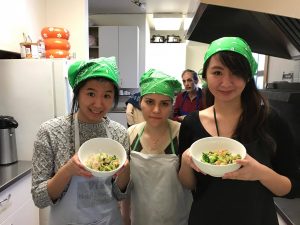 Group members displaying the delicious Nourish Bowls!
Group members displaying the delicious Nourish Bowls!